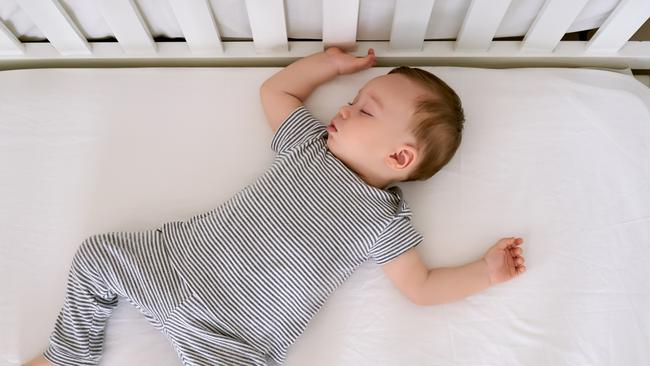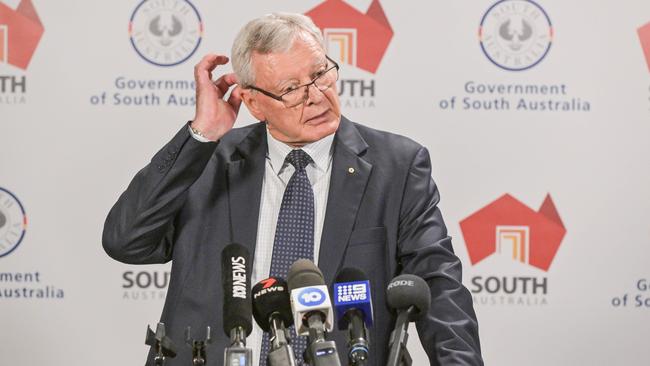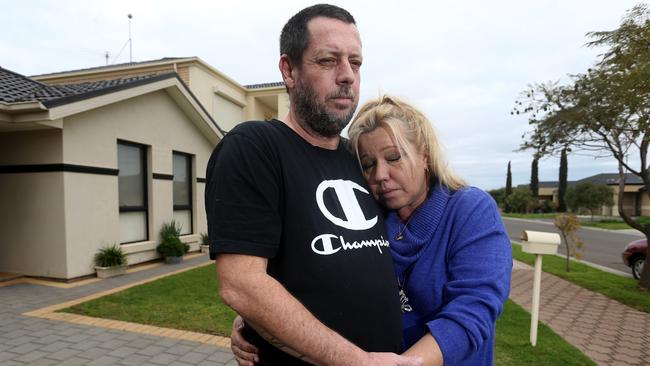Mapped: Sleep-related deaths of South Australian infants from 2005 to 2020
One factor is still contributing to deaths among sleeping babies as new analysis reveals the areas in SA were infants are most at risk. See the map.
SA News
Don't miss out on the headlines from SA News. Followed categories will be added to My News.
Loose blankets, pillows and toys left in cots are still contributing to sleep-related baby deaths in South Australia – and new analysis has revealed where infants are most at risk.
Experts have mapped every sleep-related infant death between 2005 and 2020 to reveal that far more are occurring in Adelaide’s northern suburbs.
The analysis found that more than half of all sleep-related infant deaths happen in the state’s most disadvantaged areas.
It has prompted pleas for parents to heed safe sleeping guidelines and ask for help if they cannot afford a cot or bassinet for their baby.
“These deaths are preventable, there’s really no reason why any baby in South Australia should not have access to a safe cot,” said Treasure Boxes charity founder Rikki Cooke.
Her organisation has provided 334 cots and bassinets to struggling families so far this year, up from 270 in 2021.
“These are the ones that have come forward but what about the families we don’t know about?” Ms Cooke said.
“At the beginning of the year the demand was so high we had to run an additional campaign to source more cots.
“Let’s give these families all the tools they need so it doesn’t get to crisis point.
“We don’t want to see any more babies dying.”
This week The Advertiser has reported on a coronial inquest into the death of an 11-week-old boy who was sleeping with his mother and siblings on a fold-out couch.
A report published by the Child Death and Serious Injury Review Committee says between 2005 and 2020 there were 148 sleep-related infant deaths across SA, including 54 in Adelaide’s northern suburbs, 19 in the south and 17 in the west.
Of those, 74 deaths happened in the state’s most disadvantaged areas, compared to 12 deaths among the most well-off families.

Unsafe bedding, such as loose blankets, pillows or toys in cots or bassinets, was a factor in three-quarters (109) of the 148 statewide deaths.
Other risk factors include parents smoking, covering a baby’s head or face while sleeping or putting an infant to sleep on a couch, bean bag, pillow or other unsuitable place.
“These risks can be eliminated with education about, and adoption of, safe sleeping practices,” the committee says.
“Through prevention campaigns by organisations like Red Nose, Kidsafe and SA Health, the number of infant deaths involving safe sleeping risks has declined over the past fifteen years.
“However, unsafe infant sleep practices, including unsafe bedding and bed-sharing, are still common and continue to contribute to the deaths of infants.”
‘IT’S SO FRUSTRATING’: THE CYCLE LEAVING KIDS AT RISK
Swamped child protection workers are handing almost half of their cases off to other agencies - only to have many returned in a “bottleneck” that experts warn is leaving children at risk.
The number of cases sent to welfare agencies or other arms of government has hit almost 46 per cent but those workers do not have the same powers to intervene with families.
Child protection workers have even conceded they are sending cases to agencies “when we know there are no services” to check on a family.
Two experts have recently warned the state government that many referred cases end up being closed anyway, in a cycle that wastes “precious time”, and there is no consistent process for follow-up.
The problem was highlighted in a coronial inquest this week into the death of an 11-week-old boy who died while living in squalid conditions with his teenage mother, who cannot be identified due to secrecy orders.

A social worker for a not-for-profit agency told the Coroner’s Court she attempted to check on the family at least 15 times but had no legal right to enter the home.
In the end she referred the case back to the Department for Child Protection (DCP), where it was closed days before the baby died in late 2018.
The problem with the system persists and was flagged in two reports delivered to government last month, by former police commissioner Mal Hyde and NSW child protection expert Kate Alexander.
The situation has sparked frustration among relatives of children who died after multiple red flags were raised with authorities about their welfare.
Janet Wells’ grandchildren Amber, 6, and Korey, 5, were killed alongside their mother Yvette in 2016. A coronial inquest found repeated reports were made to DCP and some were closed without action.
“It’s the same thing happening with all these kids in all these coronial inquests. It’s hard to hear,” Ms Wells said.
“The notifications are being ignored or they’re not being acted upon. It’s the same reason they give, a lack of resources. We keep talking about things changing but nothing changes. It’s so frustrating. I’m just sick of hearing it. Don’t they know how to fix it?”

Department deputy chief executive Fiona Ward said staff were fielding record numbers of concerns about at-risk children, driven by domestic violence, drug abuse and mental illness.
“We are committed to continuing to work with our partner agencies and community to ensure all children at risk receive the support they need,” she said, adding “urgent” cases were prioritised.
The department received 38,473 reports in 2020-21 about at-risk children where it deemed further action was required. Of those, 17,638 (45.8 per cent) were referred to other services. That has grown from about 25 per cent in 2017-18.
In her report Ms Alexander warns of a “bottleneck” where these reports are bouncing between departments and agencies and “hours of precious time” are wasted.
“Children are not receiving a service and the longer they wait the higher the risk,” she wrote.
DCP workers told Ms Alexander they will refer cases “even when we know there are no services” and once the case is outside of child protection “it all becomes voluntary” for families to engage.
Mr Hyde also warned government, following a review he conducted into the deaths of two other children this year, that workers outside of DCP “had a limited ability to be able to undertake their work” because they did not have the same powers to “obtain information and go to premises and make examinations”.
More Coverage
Originally published as Mapped: Sleep-related deaths of South Australian infants from 2005 to 2020





